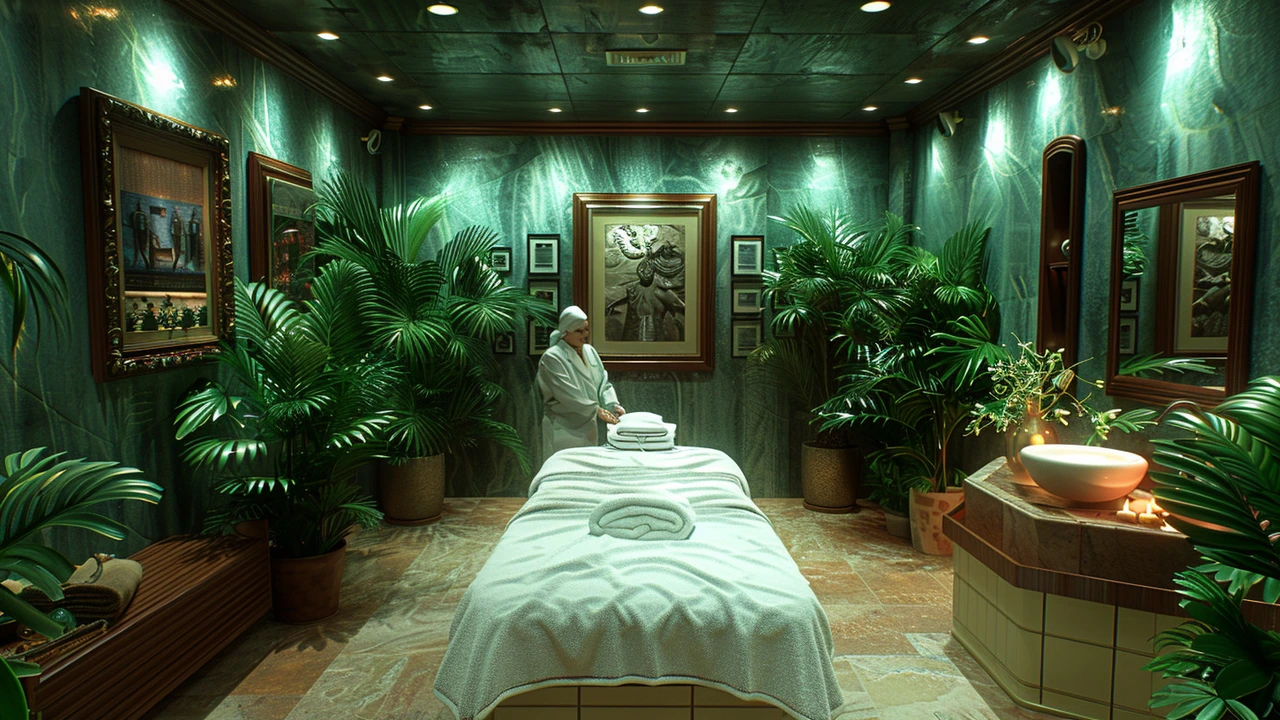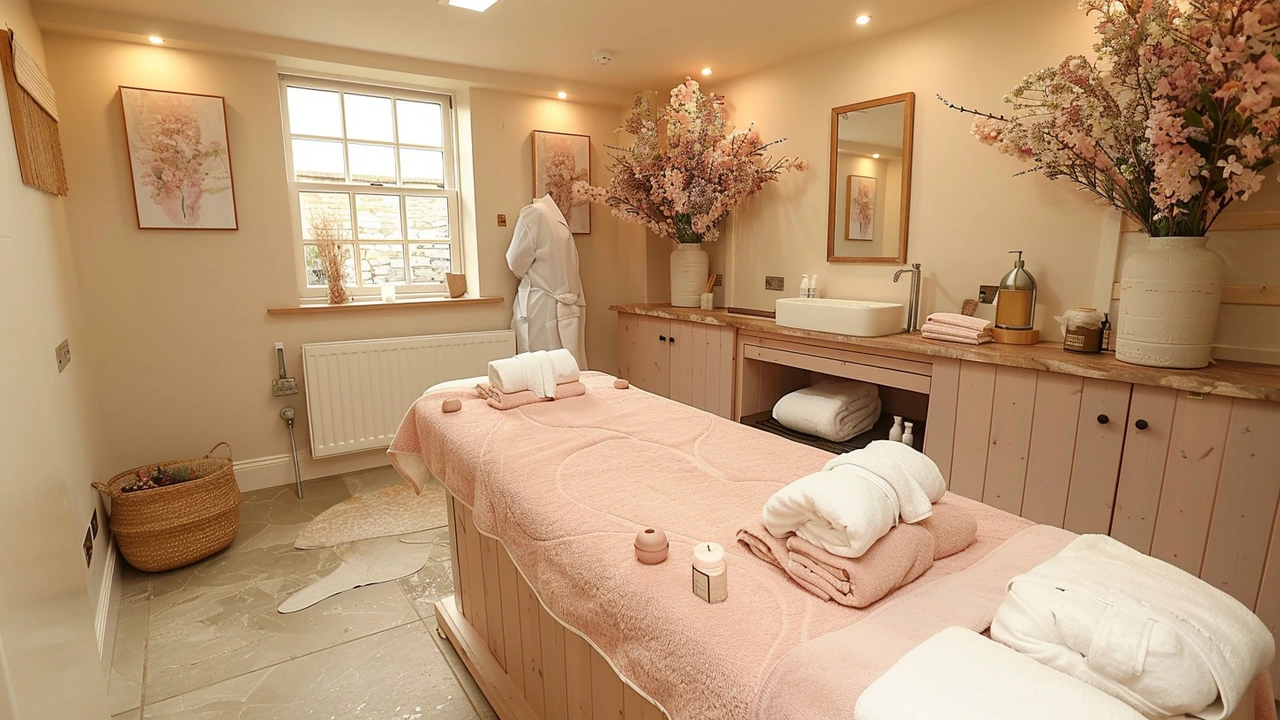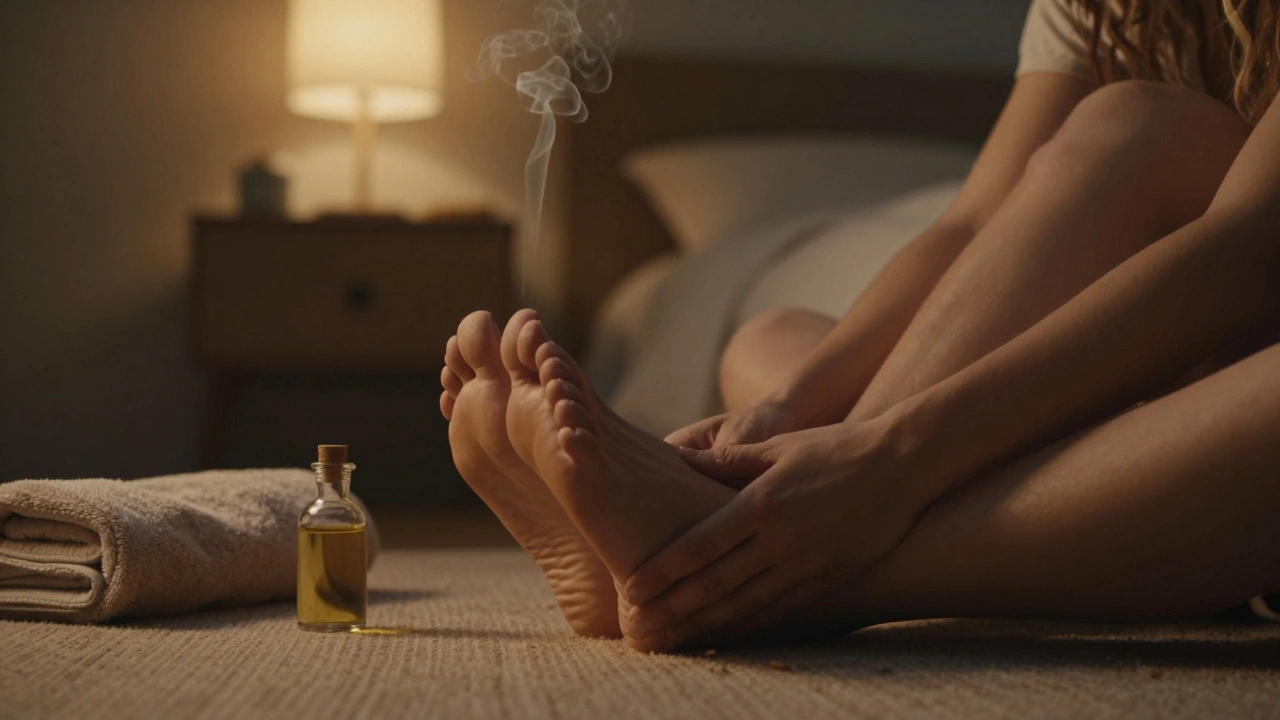Blind Massage Therapy: A Unique Sensory Healing Experience

Blind massage therapy is an intriguing and highly effective method of healing, provided by visually impaired therapists whose heightened tactile sensitivity can bring about remarkable therapeutic benefits. This unique form of massage leverages deeply intuitive touch and finely tuned techniques to deliver a sensational and healing experience.
Many people are unaware of the profound capabilities of blind massage therapists. In this article, we will delve into the core concepts, explore the numerous benefits, and shatter common myths surrounding blind massage therapy. We will also share techniques and tips on how to choose the right therapist to enhance your wellness journey. Whether you're a massage enthusiast or a newcomer, this guide offers valuable insights into this exceptional approach to therapeutic touch.
- Understanding Blind Massage
- Benefits of Blind Massage Therapy
- Debunking Common Myths
- Techniques and Training
- Tips for Choosing a Blind Massage Therapist
Understanding Blind Massage
Blind massage therapy is a unique form of therapeutic touch provided by therapists who are visually impaired. This unique practice is based on the principle that those who lack vision often develop an enhanced sense of touch, enabling them to detect subtle changes in muscle tension and the body's energy patterns. It is this heightened tactile sensitivity that allows these therapists to provide a deeply relaxing and effective massage experience.
The origins of blind massage therapy can be traced back to various cultures where visually impaired individuals were often trained in the art of massage. In countries like China and Japan, blind massage has a long-standing tradition rooted in ancient practices. Therapists in these regions are highly regarded for their ability to deliver a profound sense of well-being and healing. This traditional technique has gained recognition and popularity worldwide, as more people seek alternative and authentic forms of therapeutic touch.
Many scientific studies have highlighted the benefits of blind massage. According to a report by the Journal of Alternative and Complementary Medicine, individuals who receive massages from visually impaired therapists often experience higher levels of relaxation and pain relief compared to those who receive standard massages. The study attributes this to the therapists' enhanced sense of touch and their ability to intuitively locate areas of tension and discomfort.
"The sensitivity of visually impaired massage therapists provides a unique depth to their practice, often resulting in a more profound therapeutic outcome for clients." – Journal of Alternative and Complementary Medicine
Blind massage therapists undergo rigorous training to hone their skills. They learn various techniques such as Swedish massage, deep tissue massage, and acupressure. Their training also involves studying human anatomy and physiology to ensure they possess a comprehensive understanding of the body. Many visually impaired therapists excel in their field thanks to their dedication and heightened senses. This makes them exceptionally adept at creating personalized massage sessions tailored to individual needs.
One of the primary distinctions of blind massage is the therapist's reliance on touch over sight. This means they often use their hands as their eyes, feeling the contours of the body and identifying tension points with remarkable accuracy. The lack of visual distractions allows them to be fully present during the session, fostering a deeper connection with the client. This can lead to a meditative and profoundly relaxing experience for the recipient of the massage.
Many clients report that blind massage offers a unique depth of pressure and attention to detail. Visually impaired therapists are known for their meticulousness and intuitiveness. These qualities can transform a standard massage into an extraordinary sensory experience. This form of massage isn't just about relaxation; it is about healing on both physical and emotional levels. For some, the experience can be life-changing.
Incorporating blind massage into your wellness routine can be a transformative step. It offers a unique perspective on touch therapy and showcases the incredible capabilities of visually impaired individuals. As blind massage continues to gain recognition, it is crucial to acknowledge and appreciate this age-old practice's healing power and beauty. Whether you are looking to alleviate chronic pain, reduce stress, or simply experience a different kind of therapeutic touch, blind massage may be the perfect choice for you.
Benefits of Blind Massage Therapy
There are numerous benefits to embracing blind massage therapy as part of your wellness routine. Foremost among these is the profound level of tactile sensitivity exhibited by visually impaired therapists. Their heightened sense of touch allows them to detect muscle tension, knots, and areas of stress that might be overlooked by sighted therapists. This enhanced sensitivity enables them to tailor each session to the specific needs of the client, leading to more effective and personalized treatment.
Research has indicated that blind massage therapists often develop a keen intuition, sometimes referred to as "seeing" with their hands. This intuitive ability can translate into a deeper connection with the client’s body, facilitating better outcomes in terms of pain relief and relaxation. Various studies have also suggested that massage can help alleviate symptoms of chronic pain, depression, and anxiety, making it a valuable complementary therapy for many individuals.
The calming and stress-reducing effects of blind massage therapy can also contribute to improved mental health. By engaging in regular sessions, clients often report feeling more balanced and centered. These outcomes are particularly significant for those dealing with high stress levels or mental health conditions.
Another compelling benefit is the inclusive nature of this therapeutic approach. For blind individuals, becoming a massage therapist offers a rewarding career with an opportunity to enhance the well-being of others while showcasing their unique capabilities. This not only fosters greater societal inclusion but also challenges and changes public perceptions about the abilities of people with visual impairments.
Massage therapy, in general, can improve circulation by encouraging blood flow, which can help in healing damaged muscle tissues. Blind massage therapists, with their sharpened tactile skills, excel in techniques like deep tissue massage, which targets deeper layers of muscles and connective tissues.
"The hands are the eyes of the blind," says Dr. Amanda Wilson, a renowned occupational therapist. "In my experience, blind massage therapists often possess an unparalleled sensitivity and skill set that can make a significant difference in a client’s physical and emotional health."
The personalized care offered by blind massage therapists extends to a wide array of techniques and modalities. From Swedish and deep tissue massages to Shiatsu and reflexology, their training often encompasses various methods, allowing them to offer a comprehensive therapy that addresses multiple aspects of health and wellness.
It's important to highlight that clients who choose blind massage therapy often report a unique feeling of trust and connection during their sessions. This trust can make the therapeutic process more effective, as clients may feel more comfortable and relaxed, leading to better overall results.
Considering these diverse benefits, it’s clear that blind massage therapy isn't just an alternative form of therapeutic touch but a highly effective one that can cater to unique client needs. Embracing this approach can be a valuable addition to one's comprehensive health and wellness strategy.

Debunking Common Myths
Many myths surround the practice of blind massage therapy, often stemming from misconceptions and a lack of awareness. First and foremost, some people irrationally believe that visually impaired therapists are at a disadvantage compared to their sighted peers. This couldn't be further from the truth. In fact, because they rely more on their sense of touch, their tactile sensitivity is often heightened, allowing them to deliver deeply intuitive and effective massages.
Another common misconception is that blind massage therapists have limited training or are unqualified. This myth is particularly misleading. Most blind massage therapists undergo extensive training and certification, learning a range of techniques such as Shiatsu, Swedish, and deep tissue massage. These rigorous training programs are designed to ensure they possess all the necessary skills to address the unique needs of their clients.
There is also the unfounded belief that blind massage sessions are awkward or uncomfortable for clients. On the contrary, many clients report feeling even more at ease during these sessions. The focus and precision of blind massage therapists often create a more profound and personalized experience. Blind therapists are adept at reading the body's signals through touch, paying careful attention to areas that require more focus or have built-up tension.
Another myth is that blind massage is merely a gimmick or novelty rather than a legitimate therapeutic practice. This cynical view overlooks the substantial benefits that countless individuals have experienced. For example, mainstream recognition of blind massage therapy is growing worldwide. Many reputable spas and wellness centers now offer blind massage services, confirming its credibility and effectiveness.
There are also some who mistakenly believe that visually impaired therapists are unable to perform specialized or complex techniques. This is far from accurate. Many blind massage therapists excel in advanced techniques and regularly participate in continuing education to expand their skill set and stay updated with the latest practices in the field. Their ongoing commitment to learning and improvement makes them some of the best in their profession.
Blind massage expert Maria Jones once said, "The power of touch transcends the need for sight. Our fingers are our eyes, and through them, we can see where to provide healing and relief."
Techniques and Training
Techniques and training are critical components of the practice of blind massage therapy. The methods used by visually impaired therapists are not only unique but also remarkably effective in promoting relaxation and healing. The innate ability of visually impaired individuals to develop heightened tactile sensitivity allows them to deliver massages that are often described as more intuitive and precise.
The training for blind massage therapists typically involves a thorough and specialized curriculum. Aspiring therapists undergo rigorous programs that cover anatomy, physiology, and various massage techniques. They learn to read the body through touch, identifying muscle knots, tension, and areas that require special attention. This deep focus on tactile learning ensures that blind massage therapists are well-equipped to deliver a high-quality therapeutic experience.
Common Techniques
Blind massage therapists are skilled in a range of massage techniques. These include Swedish massage, deep tissue massage, trigger point therapy, and myofascial release. Because of their heightened sense of touch, they can often find problem areas more quickly and treat them effectively. For instance, deep tissue massage involves applying firm pressure to reach deeper layers of muscle and fascia, and blind therapists use their enhanced sensitivity to ensure the pressure is just right.
Training Programs
Training programs for blind massage therapists often include both classroom study and practical hands-on experience. Institutions that provide training typically have specialized equipment and resources to support tactile learning. Trainees practice on volunteers and are supervised by experienced instructors. These programs often last several months to a year and culminate in certification.
"The tactile sense in the blind becomes highly developed, allowing them to provide massages that can more effectively target and alleviate pain," says Dr. Ellen Marks, a researcher in sensory studies.
Additionally, many training programs for blind massage therapists include modules on communication and customer service. Given that these therapists rely on verbal feedback from clients, excellent communication skills are essential for success. Trainees learn to ask the right questions and interpret feedback to tailor the massage to each client's needs.
Continuing Education
Continuing education is also a vital aspect of a blind massage therapist's career. Staying updated on new techniques and trends in massage therapy allows them to continuously improve and offer the best possible service. Workshops, advanced courses, and seminars provide opportunities for growth and professional development. Many blind massage therapists also specialize in particular types of massage, such as sports massage or prenatal massage, further broadening their expertise.
In summary, the techniques and training involved in blind massage therapy are comprehensive and designed to harness the unique abilities of visually impaired individuals. Their heightened tactile sensitivity, coupled with rigorous training and a commitment to continuous learning, ensures that they can provide a therapeutic experience that is both effective and uniquely attuned to the individual needs of their clients.

Tips for Choosing a Blind Massage Therapist
Choosing the perfect blind massage therapist can significantly enhance your healing experience, as these professionals bring their unique touch and sensitivity to the table. To start, it’s essential to do a bit of research. Look for therapists who are certified by reputable institutions. Certification not only indicates that the therapist has undergone rigorous training, but it also ensures they adhere to industry standards of practice and ethics.
One thing to consider when choosing a blind massage therapist is their experience level. While newly certified therapists can offer excellent service, those with more years of practice may have developed a more refined touch. Don't hesitate to ask them about their experience and their approach to massage therapy. Generally, therapists with a deep understanding of the practice may be more adept at addressing specific issues or conditions you might have.
Another key point is to read reviews and get recommendations. Sometimes, word of mouth can be the best way to find a good therapist. Ask friends, family, or colleagues if they have experience with blind massage therapists. Online reviews can also provide insights into the experiences of other clients. Look for comments that mention specific positives such as technique, comfort, and professionalism.
When it comes to communication, make sure you feel comfortable discussing your needs and concerns with your therapist. An excellent massage therapist will take the time to understand your health concerns, preferences, and any areas requiring special attention or care. Communication is crucial, as it directly impacts the effectiveness of the therapy and your comfort during the session.
It's also essential to visit the massage clinic or spa beforehand, if possible. Check the cleanliness, ambiance, and facilities. A well-maintained environment speaks volumes about the professionalism of the therapist and their commitment to providing a great experience. Pay attention to how the staff interacts with clients, as courteous and respectful service is a good indicator of the overall quality of care you will receive.
According to the World Blind Union, “Many visually impaired individuals possess an extraordinary sense of touch, which can make them highly effective massage therapists.” This heightened sensitivity can lead to a more personalized and intuitive massage experience.
Lastly, an often-overlooked aspect is to trust your instincts. If you feel a positive connection and sense of reliability with a therapist, it’s likely you will have a rewarding experience. Conversely, if anything feels off, don’t hesitate to look for another therapist who might be a better fit for your needs. A comfortable and trusting relationship between you and your therapist will lead to better therapeutic outcomes.





